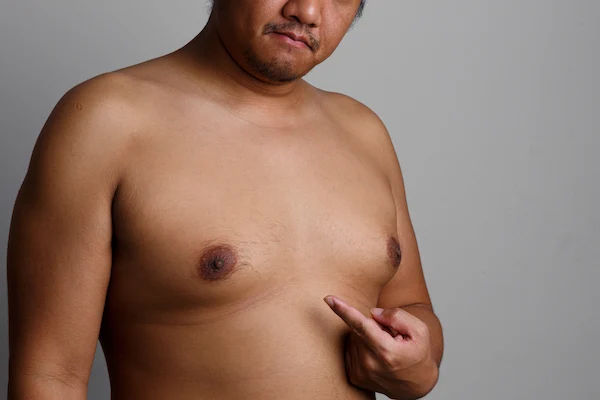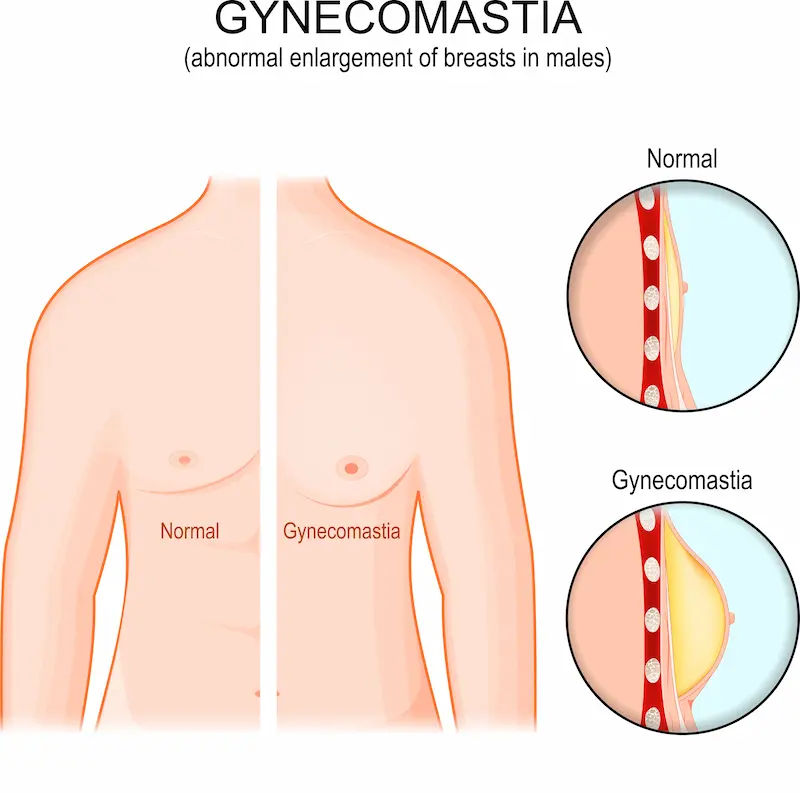How to Reduce Gynecomastia Naturally?
Discover natural ways to reduce gynecomastia (enlarged male breast tissue) through diet, exercise, and lifestyle changes. Learn the causes, symptoms, and when to seek medical advice.

Written by
Last updated on 3rd Jul, 2025
Gynecomastia, often referred to as "man boobs," is a common condition where men develop enlarged breast tissue. While it’s usually harmless, it can cause discomfort, embarrassment, and self-consciousness. The good news is that in many cases, gynecomastia can be managed or even reduced naturally through lifestyle changes.
What Causes Gynecomastia?
Gynecomastia occurs due to an imbalance between the hormones estrogen (female hormone) and testosterone (male hormone). When estrogen levels rise or testosterone levels drop, it can lead to breast tissue growth. This condition can affect men of all ages—newborns, teenagers, and older adults—but it’s most common during puberty and middle age.
Common Causes:
Hormonal changes (puberty, aging)
Obesity (excess fat increases estrogen production)
Medications (steroids, anti-androgens, some antidepressants)
Alcohol and drug use (especially marijuana and anabolic steroids)
Health conditions (liver disease, thyroid disorders, tumors)
Symptoms of Gynecomastia
Swollen or tender breast tissue
Uneven breast growth (one side may be larger)
Nipple sensitivity
If you notice sudden swelling, pain, or discharge, consult a doctor to rule out serious conditions like breast cancer.
Natural Ways to Reduce Gynecomastia
Here are some natural ways to reduce gynecomastia:
1. Maintain a Healthy Weight
Excess body fat increases estrogen levels, worsening gynecomastia. Losing weight through a balanced diet and exercise can help reduce breast tissue.
Diet Tips:
Eat lean proteins (chicken, fish, tofu)
Increase fiber intake (vegetables, whole grains)
Avoid processed foods and sugary drinks
Reduce alcohol consumption (it lowers testosterone)
2. Exercise Regularly
Strength training and cardio exercises can help burn fat and build muscle, reducing the appearance of enlarged breasts.
Recommended Exercises:
Chest workouts: Push-ups, bench presses, dumbbell flyes
Cardio: Running, cycling, swimming (helps burn overall body fat)
3. Balance Hormones Naturally
Certain foods and habits can help regulate hormones.
Zinc-rich foods: Nuts, seeds, eggs, and seafood (support testosterone production)
Omega-3 fatty acids: Found in fish, flaxseeds, and walnuts (reduce inflammation)
Avoid soy products: Soy contains phytoestrogens, which may mimic estrogen
4. Reduce Stress
Chronic stress increases cortisol, which can lower testosterone levels. Try:
Meditation or deep breathing exercises
Getting 7-8 hours of sleep per night
5. Avoid Harmful Substances
Limit alcohol (it disrupts hormone balance)
Quit smoking (nicotine affects testosterone)
Avoid anabolic steroids and recreational drugs
6. Wear Supportive Clothing
Compression shirts or vests can help minimize the appearance of gynecomastia while you work on long-term solutions.
When to See a Doctor
If natural methods don’t improve gynecomastia after 6–12 months, or if you experience:
Severe pain
Rapid breast growth
Nipple discharge
Consult a doctor to check for underlying conditions. In some cases, medication or surgery may be needed.
Conclusion
Gynecomastia is a common and often temporary condition. By maintaining a healthy weight, exercising, and balancing hormones naturally, many men see significant improvement. Remember, patience and consistency are key! If you need personalized advice, consider booking a consultation with an endocrinologist or a nutritionist through Apollo 24|7 for expert guidance.
Consult Top Sexologists
Consult Top Sexologists

Dr Rohit Ranjan
Psychiatrist
10 Years • MBBS, MD (Psychiatry)
Bengaluru
Apollo Medical Center, Marathahalli, Bengaluru
(25+ Patients)

Dr. Sreeparna Roy
Obstetrician and Gynaecologist
8 Years • MBBS , MS (OBSTETRICS & GYNAECOLOGY), Fellowship in Infertility, Endoscopy & Ultrasonography), Fellowship in Laparoscopy & Hysteroscopy,DRM
Kolkata
Dr Utsa Basu Clinic, Kolkata

Dr. Prabir Basu
Urologist
19 Years • MBBS, MS General Surgery, DNB Genito-Urinary Surgery
Jodhpur Park
Dr. Prabir Basu urology clinic, Jodhpur Park
(175+ Patients)

Dr. Johnson. S
General Practitioner
7 Years • MBBS MD(Preventive and social Medicine)
Pune
Apollo Clinic, Nigdi, Pune

Dr. Vinay D
Infectious Disease specialist
17 Years • MBBS, MD (Internal Medicine), FNB (Infectious Diseases)
Bengaluru
Apollo Hospitals Bannerghatta Road, Bengaluru
(250+ Patients)


